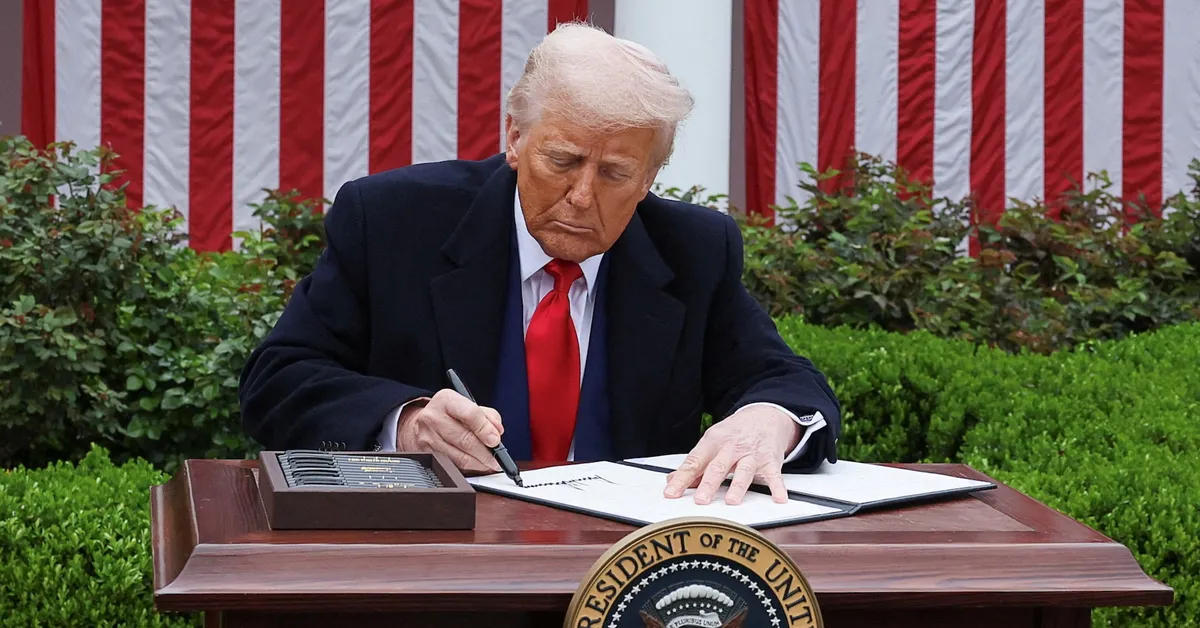
In a significant escalation of trade tensions, President Donald Trump announced sweeping tariffs on U.S. imports, affecting both allies and rivals. This move, which came into effect on April 3, has raised serious concerns about a potential global trade war that could lead to rising inflation and fears of a looming recession.
The tariffs, which were announced on Wednesday, have resulted in significant turmoil across global markets. As investors reacted to the news, stock markets in Beijing and Tokyo plummeted to multi-month lows. European stocks also faced a sharp decline, particularly impacting Germany, one of the continent's leading goods exporters. Wall Street futures mirrored this trend, dropping as investors shifted towards safer assets like bonds and gold amid rising uncertainty.
China, now facing a staggering 54% tariff on its exports to the U.S., has vowed to implement countermeasures. The European Union, traditionally a close ally of the United States, also expressed its discontent, with EU chief Ursula von der Leyen warning that the tariffs could have dire consequences for millions worldwide. The bloc is preparing to retaliate should discussions with Washington fail, indicating a united front among both allies and adversaries against Trump's measures.
Trump's new tariff structure includes a baseline 10% tariff on all imports to the United States, with higher rates imposed on key trading partners: 20% on the European Union, 24% on Japan, 25% on South Korea, and 32% on Taiwan. Even smaller territories and uninhabited islands in the Antarctic were included in the tariff list, illustrating the comprehensive nature of this policy shift.
President Trump argues that these tariffs are a response to existing duties and non-tariff barriers placed on U.S. goods by foreign nations. He claims that the new levies will bolster manufacturing jobs in America, asserting that for too long, the U.S. has been "looted" by foreign competitors. However, outside economists caution that these tariffs could slow global economic growth and inflate living costs for American families, potentially by thousands of dollars annually.
Critics of the tariffs, including financial advisory experts like Nigel Green, have voiced concerns that these measures will inadvertently sabotage the global economy. Green emphasizes that the tariffs will lead to increased prices on essential goods, exacerbating inflation at a time when it is already a pressing issue.
Interestingly, the reciprocal tariffs do not apply to certain essential goods, including copper, pharmaceuticals, semiconductors, and various minerals that are not readily available in the United States. Additionally, Trump has signed an order to close the de minimis loophole that allowed low-value packages (valued at $800 or less) to enter the U.S. duty-free, particularly from China and Hong Kong. This order, effective May 2, aims to curb the influx of fentanyl into the country.
The implications of these tariff policies extend beyond immediate market fluctuations. The global manufacturing sector has already begun to slow due to tariff concerns, while consumer behavior is shifting as people rush to buy imported products before prices rise further. French Prime Minister François Bayrou expressed that the situation poses a catastrophe not only for Europe but also for American citizens.
As the reality of the new tariffs begins to settle, companies worldwide are faced with the complex challenge of adapting their strategies in response to these sweeping changes. The uncertainty surrounding global trade relationships continues to grow, highlighting the profound impact of the U.S. tariffs on both national economies and international collaborations.